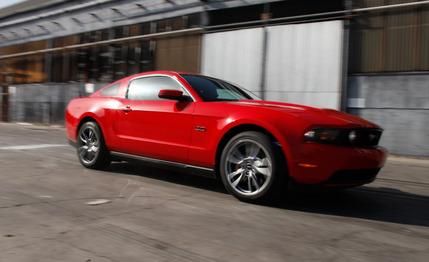 Short Take Road Test
Short Take Road Test
The ingredients needed to make a Mustang: horsepower, horsepower, and more horsepower, plus a chrome pony, a glove box, and a cigarette lighter. Thankfully, Ford has embellished on this old-fashioned recipe with a car that handles, gets decent fuel economy when driven mildly, and doesn’t consume your driveway like the much larger and heavier Chevy Camaro and Dodge Challenger.
Since the Mustang went into production 46 years ago, Ford has made steady and incremental improvements almost every year. The car has benefited, rising to the top of the muscle-car heap as others stagnated or went out of production. This year the changes are big, starting with a new four-cam, 32-valve, aluminum-constructed 5.0-liter V-8.
Oh, That Fabulous Five-Point-O
You can read the minute technical details of this engine elsewhere on this site, but here’s what you need to know: It’s utterly fabulous, a 7000-rpm cavalry charge that generates incredibly smooth, linear thrust across its broad rev band. Were you to paint the cam lids red and stick on a chrome trident, most Maserati owners would never know the difference. Yes, it’s that good.
The 412 hp and 390 lb-ft of torque, the latter on a gloriously flat curve that peaks at 4250 rpm, are achievements. It’s enough to knock out a 60-mph sprint in 4.6 seconds, and the quarter-mile in 13.2 seconds at 109 mph, which are more or less Camaro SS times. Finally, a Mustang engine that doesn’t have to eat dust from a small-block.
But horsepower doesn’t tell the whole story. This V-8 is a major evolutionary step for Ford, perhaps the best gasoline burner the company has ever produced. It twists the tach needle quickly and without vibration but with a roar so menacing it makes the Camaro SS sound like a pickup truck. Detroit has long made cars that leap off the line in a burst and then flame out shortly thereafter. Ford has tuned the V-8’s throttle to be remarkably gentle and progressive, as if road racers in ballet shoes were the final editors of the software. Dare we say it? This engine is too good for this car.
For 2010, Ford spruced up the Mustang’s interior with soft-touch materials and more brightwork. But to get the full effect, you have to buy the Premium upgrade, a $3200 hit. On the base GT, plain, deep-grained plastic abounds, the steering rim a no more thrilling ring of plastic to grip than a Hula Hoop. The base interior is a bit impoverished considering the $30,495 starting price, much less our $32,980 as-tested sticker.
There are two new six-speed transmissions, and the manual we tested has very closely spaced gates maneuvered by a short shifter that slides your forearm across the center console and parking-brake handle and brings it into conflict with anything in the cup holders.
What Was Good Is Now Even Better
Fitted with the 255/40ZR-19 Pirelli P Zero tires that are standard on the GT, the car pulled 0.94 g on the skidpad, a testament to the grip afforded by these tires (which are now found on both Mustangs and Camaros). Last year, a 2010 Mustang beat a Camaro and a Challenger in a comparison test based largely on its handling merits, and the new model is even better. It turns sharply and holds a precise trajectory through a turn. Although the rear end remains a live axle, the body isn’t tossed off course by pitching pavement or camber changes. In matchups with the independently sprung Camaro, we’ve come away lauding Ford’s decision to stick with the live axle. The company has made it work, and if it saves weight and the customer money, so much the better.
What’s not better is the capless fuel port Ford adopted last year. The idea of getting rid of a fussy, hard-to-turn cap is great—except that we always seem to spill fuel on the car and on our shoes. And after some hard cornering on a full tank, we noticed signs of weeping down the Mustang’s quarter-panel where dust had collected in the dampness. Last year, Ford told us there was a problem with early filler necks and that it had been fixed. What does it have to tell us now?
Although its neighbors have come and gone from this area of the market, Ford has stuck it out, and its perseverance has paid off. If the new “Coyote” 5.0-liter isn’t the best engine the company has ever made, this is unquestionably the best Mustang in a long line and probably the best car Ford sells in the United States. It accomplishes its mission with such aplomb that you wonder why Ford can’t attack the weak points in its lineup—the Taurus, for example—with the same fervor.